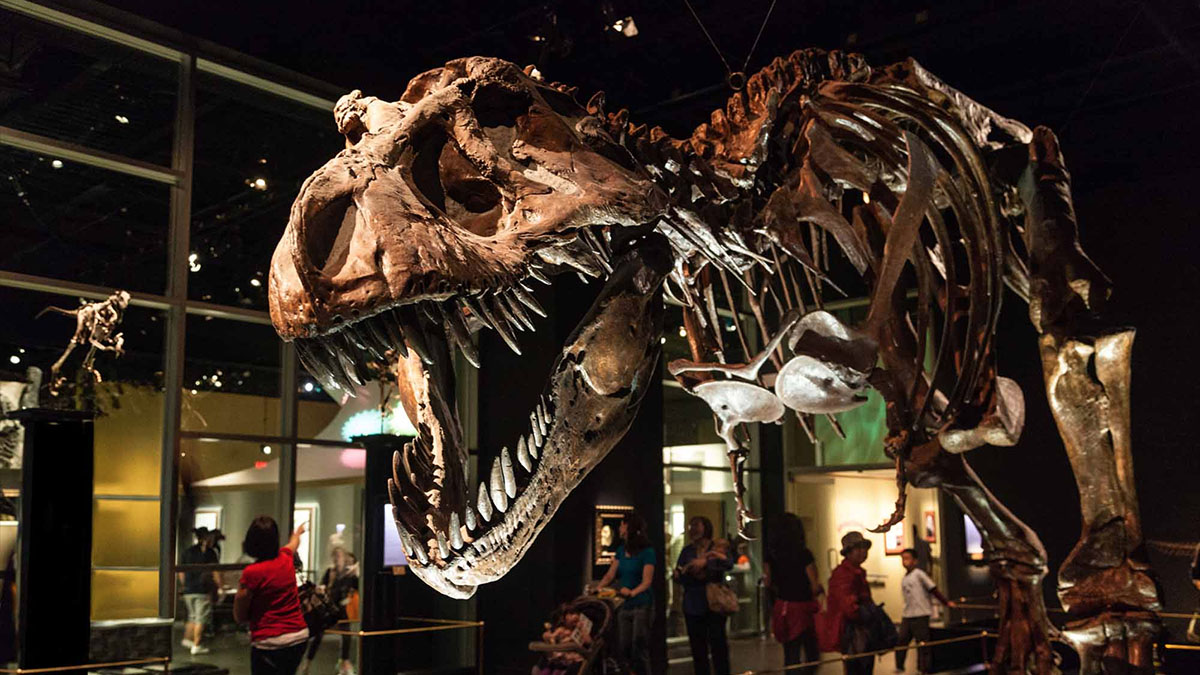scavenger or predator, the great t. rex debate

Typically, when we think of Tyrannosaurus Rex, we envision a giant killing machine with titanic jaws and huge teeth that could crunch through bones as thick as our arms and legs. Or, if you’re a fan of Jack Horner, you’re probably thinking of a five ton scavenger roaming the badlands and terrifying every smaller predator to sink its teeth into a fresh kill made for him by others. It’s an ongoing debate since the animal in questions isn’t exactly around for us to observe and we have very few fossils from which we can make a couple of deductions.
What we do have doesn’t help all that much either because the T. rex had the typical attributes of a predator like big eyes pointed forward, plenty of muscle to deal punishing blows with its head, and a bite force that could crush a car’s canopy, but it also had the awesome sense of smell of a scavenger, ran relatively slowly, and its little forelimbs were useless. However, as paleontologists point out, he may not have needed the forelimbs since his head was a weapon in itself, and what he chased was probably even slower than him. And a great sense of smell probably wasn’t a big detriment. So how can we tell if T. rex was a carnivore, a scavenger, or both?
Judging an animal based solely on its features won’t yield a conclusive result, as you can probably see by the examples above. Sure the T. rex had features of a scavenger, but looking like a menacing predator and being able to fight and bring down prey on its own would’ve given him an evolutionary advantage. Likewise, having a scavenger’s nose and overwhelmingly powerful jaws wasn’t going to hurt him as a hunter either. Trying to get an idea of how and what it ate by analyzing fragmented fossils and fossilized dung gives us far too small of a sample size to make any sort of determination. After all, how can we accurately judge an entire species solely by a handful of traces of its existence? An awkward bite mark on a fossil doesn’t cast all of T. rex-dom into the role of scavengers.
For all we know, it may have been a one-off event preserved by random chance and giving us a very skewed picture of the past. However, what about the T. rex’s energy requirements? If it could simply scavenge what it needs, that would make the case for its status as a walking carrion seeker more likely. And according to a study in 2003 which averages out the distribution of animals and animal carcasses across the T. rex’s domain to approach that of the modern Serengeti, it could well have just scavenged its way around to meet its daily caloric requirements. It may have went hungry on some days, but not all.
So based on that study, we can say that T. rex may have been either a scavenger, or a scavenger which killed its own prey once in a while, right? Not so fast. A recently published review of that study noticed a very, very big omission that changed the numbers entirely. The calculation of how much food T. rex could find didn’t include any competitors also on a lookout for the stray, edible carcass. Not only that, but most of the carcasses would be pretty small since smaller predators would have a hard time bringing down immense herbivores traveling in vast herds, and they’d be first at the scene of a recently dead giant in swarms big enough to put up a major fight that a T. rex might want to avoid. There were also large competitors that could go toe to toe with our huge carnivore on their own.
Taking all this into account, the new set of calculations shows that our five plus metric ton subject would go hungry on a constant basis if it didn’t kill and keep its own food. Otherwise, between the other predators and scavengers, decomposition, and ranges of detection, a scavenger T. rex would be pretty much doomed to starvation. Now we’re back to the current idea that T. rex was both a predator and scavenger just like many predators today won’t turn down a fresh enough carcass. But was it mostly a scavenger which killed when it could, or was it a predator who had a good nose for potential prey and a free meal? That’s really not something we can find out. Neither the fossils nor the equations are of any help here.
Since we’re dealing an animal that hasn’t been around for 65 million years, all we’ll know is that it was a huge carnivore and that it met its caloric requirements well enough to reproduce. Now, we can also say that it likely used some mix of hunting and scavenging to do that because we do have a couple of cases of opportunistic biting and scavenging in the fossil record, but scavenging alone wouldn’t have sustained it for long. The ratio of predation to scavenging though, is a much more complicated problem requiring a lot of guesswork and big assumptions about the T. rex’s environment. And since we’ll never get the chance to observe it going about its day, I suppose we’ll never really have an answer to many of our questions about this creature.
See: Ruxton, G., Houston, D. (2003). Could Tyrannosaurus rex have been a scavenger rather than a predator? An energetics approach PRS B: Biological Sciences, 270 (1516), 731–733 DOI: 10.1098/rspb.2002.2279
Carbone, C., Turvey, S., & Bielby, J. (2011). Intra-guild competition and its implications for one of the biggest terrestrial predators, Tyrannosaurus rex PRS B: Biological Sciences DOI: 10.1098/rspb.2010.2497





